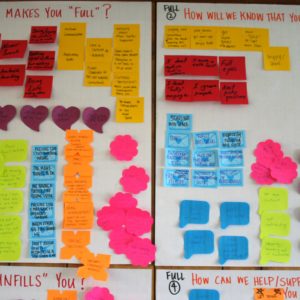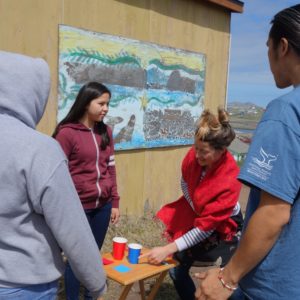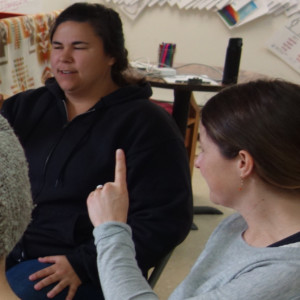[vimeo=21673263]
How do you apply WAYK techniques to building a video curriculum?
As you know, WAYK is a design system for accelerating and improving the learning in any environment. So then how do you apply techniques obviously!, set-up, limit, and so on, to video?
Video presents certain challenges – the biggest is the loss of the in-person TPR (total physical response) environment. However, all the other techniques are still in play. How much can we engage the viewer, and include them in a conversation (tq fluency, everybody plays, same conversation)? How much can we apply my turn/your turn?
For us at WAYK, we’ve also been handicapped by the limitations of our technical video know-how. If you’ve been on this ride with us for a while, you’re aware of the infamous audio problems in our early videos, the confusing (via video) set-ups, and so on.
Recently we’ve had the chance to partner with videographers more skilled than us (fluent fools at last!), and so in that partnership we’ve been developing an “ideal” format that we’re modeling for you to copy-cat.
To be perfectly clear: our goal is to develop a same conversation for how language videos are made, a near-universal format so that anyone can experience accelerated learning for any heritage language video on youtube or other video hosting sites.
For video there will always be learning decelerators in play (such as the lack of TPR), but the ability to access them anywhere via the internet brings a massive amount of acceleration to learning that more than makes up for the challenges.
Compare the Chinook Jargon video at the top of this post to this video of Irish:
[vimeo=19896067]
Yikes! Note the difference. Both videos have some important techniques applied to the video format; both have obviously! close-ups of the props in play, for example. However, the visual field for the Irish video is extremely cluttered. The Irish video is twice as long as the Chinook video. There are multiple players, but no one is pulling you (the viewer) through it. It has a lengthy intro, so you’ll need to edit it to be shorter if you want to put it on a loop and listen/watch until you’ve got it (or have it running over and over in the background). Also, one of the objects on the table is almost impossible to see (the penny owned by Patrick).
The Chinook Jargon video is ready to go; it has been stripped of an intro and outtro (application of limit) making it perfect for looping, the visual field is completely focused on play, with tq bluescreen/greenscreen applied to the environment. Now we’re talking! Keep in mind, the Chinook Jargon videos were filmed in an empty classroom at the Portland State University Native American Student and Community Center – not a specialized studio. It doesn’t take much to limit the set-up!
We encourage you to copy-cat along with the rest of these Chinook Jargon videos and experience the improved format, while thinking, “what other techniques can I apply to improve this?” One question we still have is, “how many (and which) techniques should we introduce at the beginning of each videos? How should we vary that?” For example, I mark bite-sized pieces at the beginning of each of these videos, and for the first one, also mention copy-cat.
Here’s the rest of the videos, up to want/have/give/take, I hope you enjoy them. One big opportunity for improving these videos is to have two players in the video, so that they can more obviously! model the goal conversation for the viewer-player. However, sometimes you only have one speaker who can put together a game like this for video – so these provide a good example of dealing with the toughest situation.
Chinuk Wawa 2
Chinuk Wawa 3
Chinuk Wawa 4
Chinuk Wawa 5





Hi Willem. First, I’d like to say that since stumbling onto your website a few days ago, I’ve been devouring the available materials voraciously. I’m finding the system and the ideas embedded in it profoundly inspirational and personally transformative. I want to thank you and Evan for sharing and creating it.
I’ve gone through this series of Chinuk Wawa videos in two sittings, last night and tonight, and I have some feedback to share about my experience. I found the first three videos wonderfully effective. It amazed me how naturally I fell into the rhythm of the conversation, speaking and signing right along with the video without even thinking about it. It cut right through my natural extreme tendency to overanalyze, and shut that part of my brain off (no easy feat in my case!) so I could feel, instead of think about, the language.
The fourth video was a little more challenging for me, for the reasons you acknowledge in the post above, but I just called “TQ: Full” on myself after my first try, and came back to it again tonight, and was able to get through it fairly well. Not quite as smooth, but you already seem to know about the issues with that one.
The fifth one defeated me, I’m sorry to say. I don’t think it’s a “Full” issue in this case. I’m not entirely sure, because I couldn’t keep up, but I think only two of the four words in the Craig’s List were used in the video. I think the Craig’s List could have benefitted from more “TQ:Limit” and “TQ:Slow” in the presentation. I also think a bit more of the repetitive drilling process with using the new words in simple sentences before shifting to a more natural conversational rhythm would have worked better for me. As it was, I wasn’t able to follow along and pick up the language in the same natural-feeling way as with the earlier videos. I’ll come back to it and try again later, but that’s where I’m at for now.
All this is in the spirit of offering feedback, as it seemed to me you were seeking in the post above, in the interest of continuing to improve these video templates. Again, I think you’re doing amazing work and I’m thoroughly impressed with how well this system works. Thanks again for getting it out there!
Matt,
Thanks so much for your feedback. We’ll incorporate your observations into the next videos we’ll do.
And welcome to the WAYK play community! So good to hear you’re enjoying playing through the online material – please join in on the google discussion group if you have any further questions or observations.
yrs,
Willem
[…] their languages. While WAYK works best in a live situation such as above, they are also developing a video library for situations where live communication is not possible. Here is a video with a first lesson in […]
Matt
Have you put yourself on the map yet?